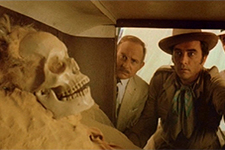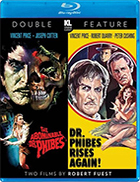Dr. Phibes Rises Again [Blu-Ray]
|

The 1972 capsule review of Dr. Phibes Rises Again in the British publication Punch describes it as an "utterly absurd and ridiculous exercise in Pinewood-Gothic-baroque," and I really can't think of a better descriptor. A quickie sequel to the low-budget American International horror-comedy The Abominable Dr. Phibes (1971), which found Vincent Price's eponymous protagonist tracking down and murdering in glorious fashion all of the men he blamed for his wife's death on the operating table, Rises Again takes all of that film's art-deco grandiosity, dark humor, and absurdist horror in-jokes and ramps them to another level. Unfortunately, it is also hampered by lots of post-production editing and squabbling that renders chunks of the film incoherent without voice-over narration and results in a film that moves in awkward fits and starts, lurching from deranged near brilliance to simple clumsiness. A quick recap at the beginning of the film sets the stage, filling in all the story from the first film just in case anyone in the audience hadn't already seen it. Price's musician-turned-murderer Dr. Anton Phibes puts himself into a three-year state of suspended animation alongside his wife's elegantly maintained corpse, only to—ahem—rise again when the moon enters into a specific alignment with the planets for the first time in 2,000 years. This alignment has something to do with his being able to pursue eternal life and resurrect the missus using the River of Life, which flows beneath a hidden pyramid in Egypt. Unfortunately, he is in competition with Darius Biederbeck (Robert Quarry), a centuries-old man who manages to look not much more than middle-age due to his use of a magical elixir, which is almost running out. And speaking of eternal life and resurrections, Dr. Phibes is once again aided by his silent partner Vulnavia, who died in the first film, but is inexplicably still alive here and played by a different actress (former Miss Australia Valli Kemp, replacing Virginia North, who was pregnant at the time and therefore couldn't fit into Vulnavia's various form-fitting dresses). Thus, we have the set-up, with Dr. Phibes competing with Biederbeck for the various tools (a scrap of papyrus, a hidden key) needed to access the River of Life, while Phibes is being pursued once again by the determined, but genially incompetent Scotland Yard Inspector Trout (Peter Jeffrey) and Superintendent Waverley (John Cater). Luckily, Biederbeck has a host of assistants working with him, which provides Dr. Phibes with plenty of victims on whom he can unleash his absurdly complicated murder scenarios (one involves luring a character into a giant, golden scorpion chair whose claws clamp down on his arms, leaving him at the mercy of dozens of actual scorpions). None of this is played as anything other than horror-comedy ad absurdum, with returning director Robert Fuest admitting in interviews that he was basically trying to send up Dr. Phibes, who was already a send-up of mad horror-movie villains. Price once again lends his air of camp elegance to the mad doctor, leering with his eyes and his cheekbones because the character can't speak (he must do so through a device that attaches to the side of his neck, so that even when he speaks his mouth doesn't move). Nevertheless, Dr. Phibes has plenty of dialogue, much of which was added in post-production to fill in the gaps left by the chainsaw editing done to film's initial cut. Left in are a few one-scene cameos by familiar British character actors Peter Cushing (who has a literal walk-on as a ship captain) and Terry-Thomas, who can always be counted on for his erudite, upper-crust farcicality. Dr. Phibes Rises Again is not a particularly good movie, but it is never boring and always gaudily gorgeous to look at. The sets by returning designer Brian Eatwell (The Three Musketeers, The Man Who Fell to Earth) never fail to impress, whether it be Dr. Phibes's funktastic multi-colored organ and attendant creepy-as-hell clockwork musicians, or a giant pair of stone feet buried beneath the Egyptian sands. This is a film that is designed from end to end to catch your attention. Much of the production belies the relatively cheap budget (they were able to recycle a lot from the first film), and the cinematography by Alex Thomson, who would go to earn an Oscar nomination for his work on John Boorman's Excalibur (1981), gives it a veneer of contrasty Technicolor flamboyance. Yet, as fun as it often is, Dr. Phibes Rises Again feels too cobbled together to work as well as the first film. It has its delicious moments, to be sure; but, as a whole, it feels slightly warmed over, never quite living up to its delirious promise.
Copyright © 2022 James Kendrick Thoughts? E-mail James Kendrick All images copyright © Kino Lorber | |||||||||||||||||||||||||||||
Overall Rating:



 (3.5)
(3.5)
Subscribe and Follow
Get a daily dose of Africa Leader news through our daily email, its complimentary and keeps you fully up to date with world and business news as well.
News RELEASES
Publish news of your business, community or sports group, personnel appointments, major event and more by submitting a news release to Africa Leader.
More Information
